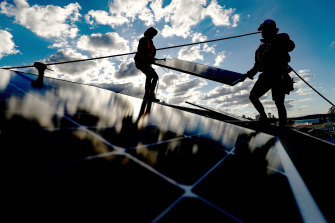Australia’s power grid is set up to cope with coal’s continued decline over the next decade, the market operator has declared, even as a flood of cheap electricity from solar and wind farms under cuts traditional power plants’ profits.
Fossil fuel-based generators have been under financial pressure over the past year as renewables drive down daytime power prices to levels where coal and gas struggle to compete. South Australia’s Torrens Island B gas plant is set to mothball one unit next month, Victoria’s Yallourn Power Station is set to shut four years early in 2028, and one unit at NSW’s Eraring Power Station will shut in 2030.
Continued growth in large-scale renewables and rooftop solar power is reducing the demand for coal-fired power. Credit:Bloomberg
State and federal governments are working on plans to cope with the danger of more early power plant closures amid concerns sudden exits could disrupt electricity supply.
However, the influx of wind and solar power, coupled with the boom in rooftop solar and investment in new transmission lines, is expected to fill the void because it will be backed by investment in dispatchable power projects – providing on-demand energy from new gas, batteries or pumped hydropower.
“Over the next five years we’ve got sufficient supply to meet the required reliability standards,” the Australian Energy Market Operator’s (AEMO) chief executive Daniel Westerman said, noting that power projects in the pipeline were progressing well. “In the subsequent five years we are confident about the anticipated generation and storage projects as well.”
AEMO forecasts rooftop solar would continue its boom and by 2026 would on its own supply 77 per cent of the demand in the National Electricity Market during the day.
However, rooftop solar is drastically reducing daytime demand, and its cheap cost of supply is eating into the business cases for traditional power plants.
That means large-scale power generation, which is still essential to satisfy peak demand when the sun isn’t high in the sky, has less money-making potential.
“Australia’s love of rooftop solar is going as strong as ever, so the minimum operational demand is likely to cause us the biggest challenges by 2025,” Mr Westerman said.
“Without additional operational tools, we may no longer be able to operate the (electricity market) securely in all periods from 2025 due to a lack of security services when demand from the grid is so low.”
A reform being investigated by state and federal governments may help address this, Mr Westerman said. Under the proposal for a “capacity mechanism”, retailers would pay generators to guarantee future supply by remaining in the grid or investing in new assets.
Green Energy Markets analyst Tristan Edis said state and federal governments “have funded the construction or made very firm promises to construct a huge pipeline of thousands of megawatts of dispatchable capacity as well as transmission projects that should mean we will have plentiful supplies of dispatchable capacity to maintain reliability as coal generators exit”.
AEMO’s latest upgrade has also lifted its expectations for renewables penetration into the grid. In June Mr Westerman said it was a “goal” for the grid, usually powered by about 70 per cent coal, to be able to handle an influx of 100 per cent renewable power at certain times.
“Australia’s energy transition really does continue at pace and now our base case forecast by 2025 is the national electricity market can be supplied by 100 per cent renewable energy,” he said.
Liam Mannix’s Examine newsletter explains and analyses science with a rigorous focus on the evidence. Sign up to get it each week.
Most Viewed in Politics
From our partners
Source: Read Full Article

